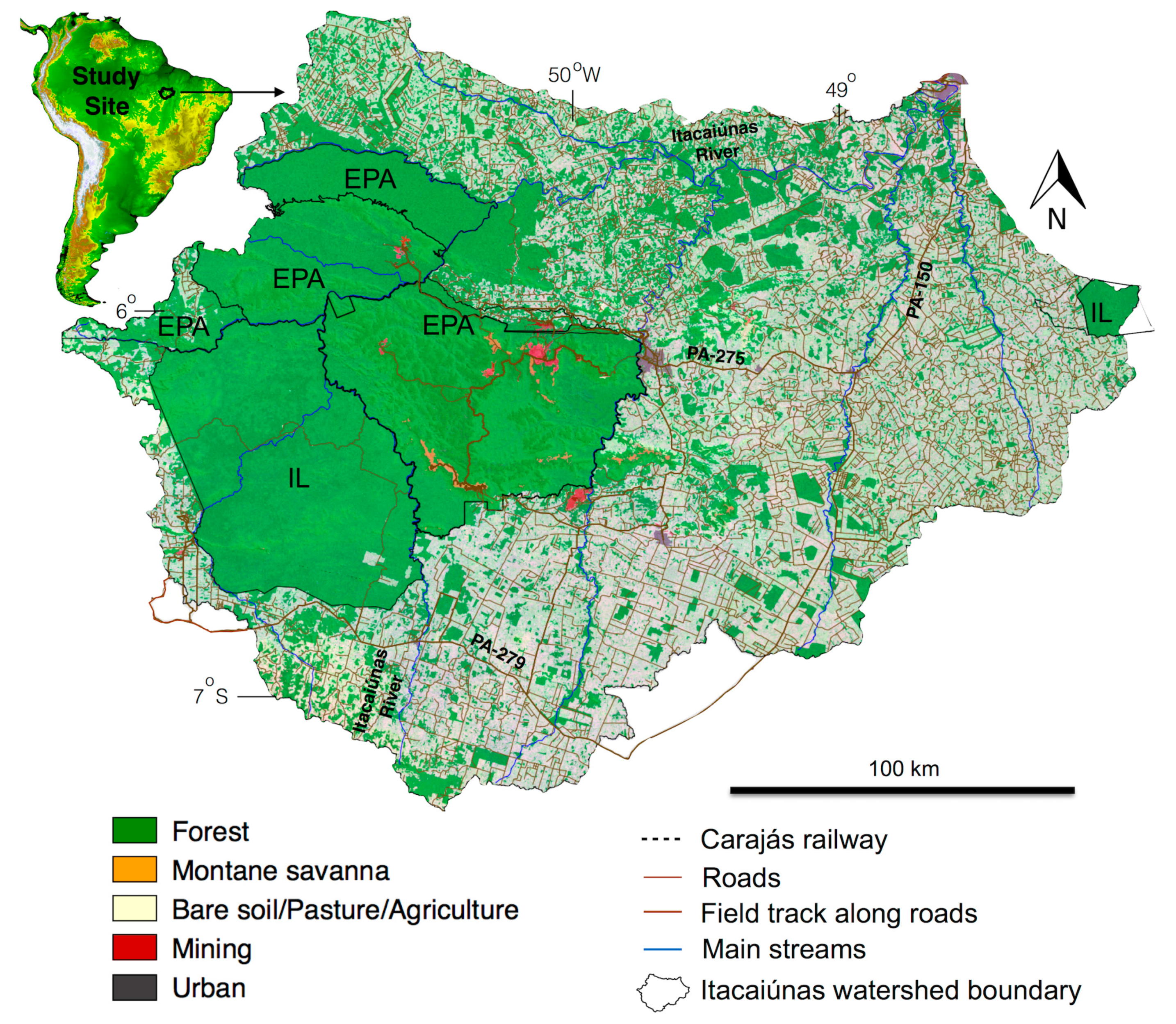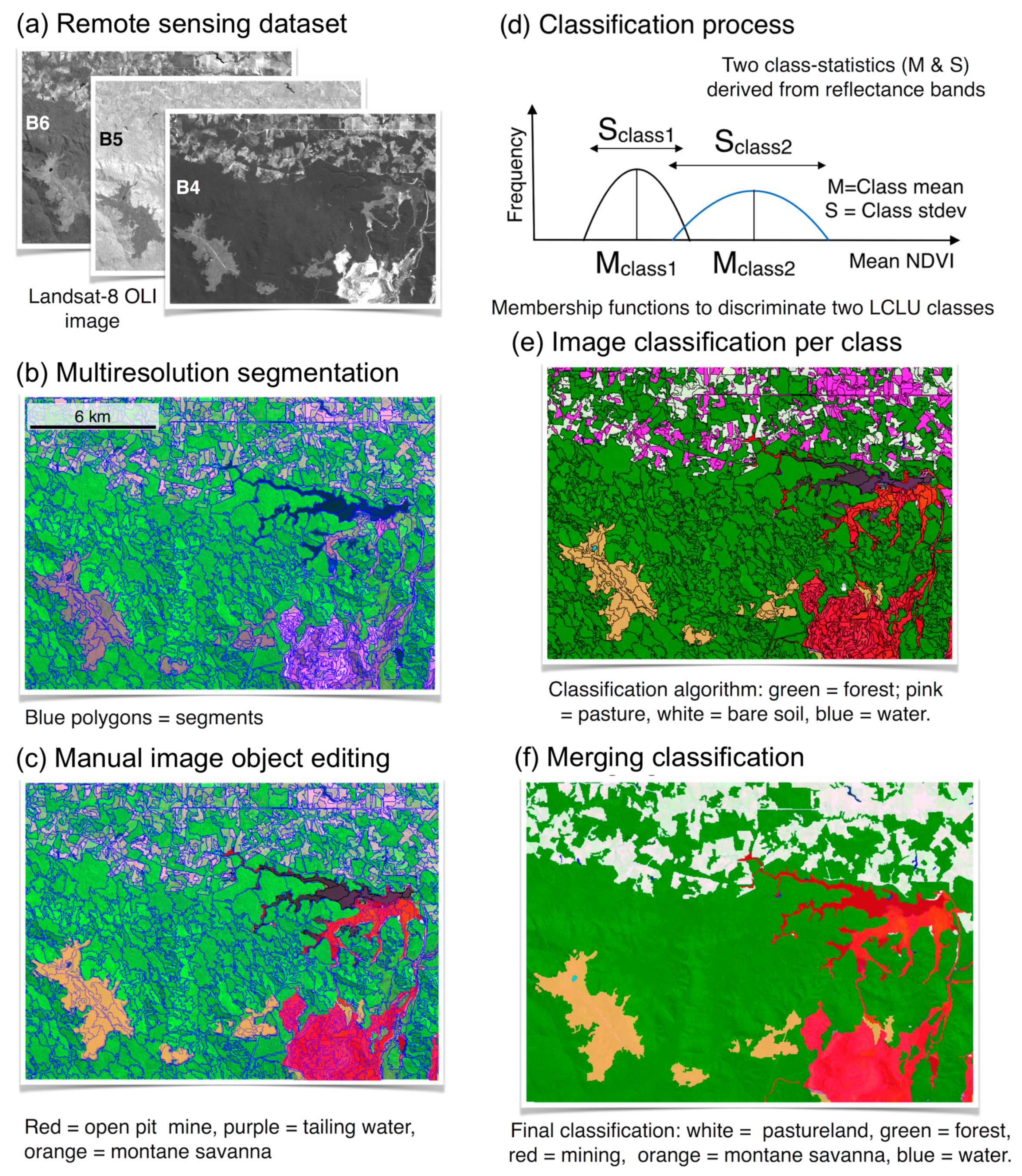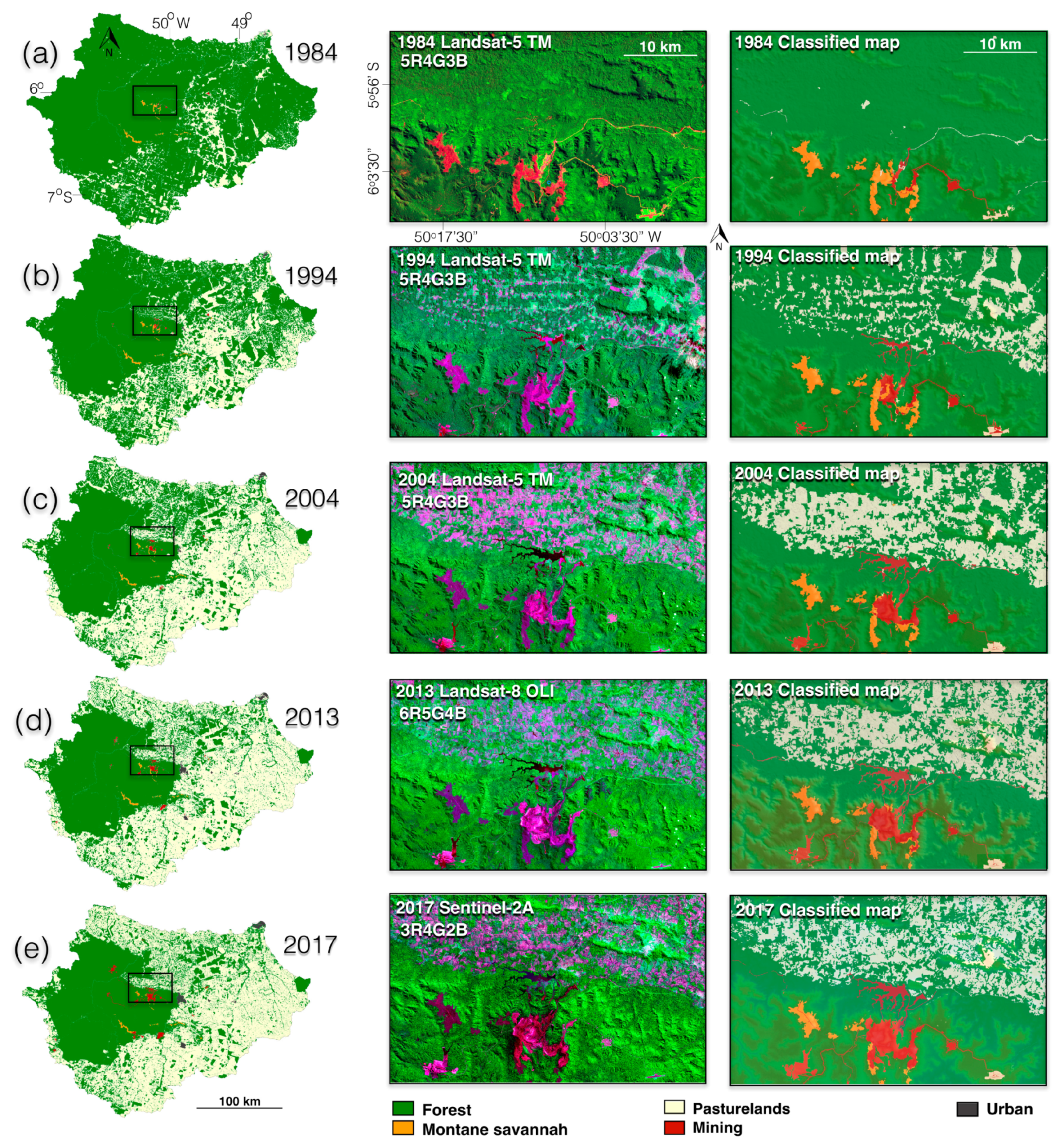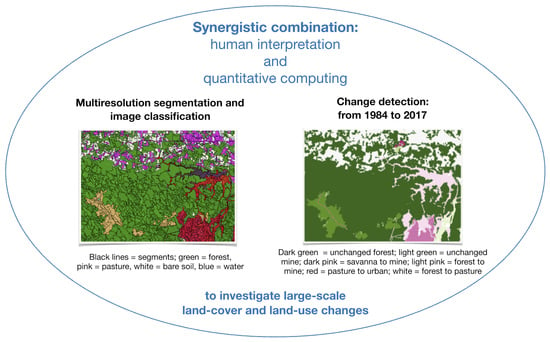A GEOBIA Approach for Multitemporal Land-Cover and Land-Use Change Analysis in a Tropical Watershed in the Southeastern Amazon
Abstract
:1. Introduction
2. Dataset and Methods
2.1. Study Area
2.2. Remote Sensing Dataset and Field Data Collection
2.3. Digital Image Processing
2.4. Geographic Object-Based Image Analysis (GEOBIA)
2.4.1. Segmentation
2.4.2. Multiresolution Classification
2.4.3. Classification Accuracy Assessment of the LCLU Classes
2.4.4. Object-Based Change Detection Analysis
3. Results
3.1. Overall Classification and Accuracy Assessment of Multitemporal LCLU Maps
3.2. Analysis of Multitemporal LCLU Changes
3.3. LCLU “from-to” Change Detection Analysis
4. Discussion
4.1. Issues of Accuracy for Multitemporal LCLU Classes
4.2. LCLU Assessment Using Time Series Satellite Images and GEOBIA
4.3. LCLU “from-to” Change Detection Approach
5. Conclusions
Supplementary Materials
Author Contributions
Funding
Acknowledgments
Conflicts of Interest
References
- Singh, A. Review article digital change detection techniques using remotely-sensed data. Int. J. Remote Sens. 1989, 10, 989–1003. [Google Scholar] [CrossRef]
- Lu, D.; Li, G.; Moran, E.; Hetrick, S. Spatiotemporal analysis of land-use and land-cover change in the brazilian amazon. Int. J. Remote Sens. 2013, 34, 5953–5978. [Google Scholar] [CrossRef] [PubMed]
- Blaschke, T.; Hay, G.J.; Kelly, M.; Lang, S.; Hofmann, P.; Addink, E.; Queiroz Feitosa, R.; van der Meer, F.; van der Werff, H.; van Coillie, F.; et al. Geographic object-based image analysis—Towards a new paradigm. ISPRS J. Photogramm. Remote Sens. 2014, 87, 180–191. [Google Scholar] [CrossRef] [PubMed]
- Burnett, C.; Blaschke, T. A multi-scale segmentation/object relationship modelling methodology for landscape analysis. Ecol. Model. 2003, 168, 233–249. [Google Scholar] [CrossRef]
- Liu, D.; Xia, F. Assessing object-based classification: Advantages and limitations. Remote Sens. Lett. 2010, 1, 187–194. [Google Scholar] [CrossRef]
- Platt, R.V.; Rapoza, L. An evaluation of an object-oriented paradigm for land use/land cover classification. Prof. Geogr. 2008, 60, 87–100. [Google Scholar] [CrossRef]
- Tompoulidou, M.; Gitas, I.Z.; Polychronaki, A.; Mallinis, G. A GEOBIA framework for the implementation of national and international forest definitions using very high spatial resolution optical satellite data. Geocarto Int. 2016, 31, 342–354. [Google Scholar] [CrossRef]
- Garcia-Pedrero, A.; Gonzalo-Martin, C.; Fonseca-Luengo, D.; Lillo-Saavedra, M. A GEOBIA methodology for fragmented agricultural landscapes. Remote Sens. 2015, 7, 767–787. [Google Scholar] [CrossRef]
- Blaschke, T. Object based image analysis for remote sensing. ISPRS J. Photogramm. Remote Sens. 2010, 65, 2–16. [Google Scholar] [CrossRef]
- Chen, G.; Hay, G.J.; Carvalho, L.M.T.; Wulder, M.A. Object-based change detection. Int. J. Remote Sens. 2012, 33, 4434–4457. [Google Scholar] [CrossRef]
- Desclée, B.; Bogaert, P.; Defourny, P. Forest change detection by statistical object-based method. Remote Sens. Environ. 2006, 102, 1–11. [Google Scholar] [CrossRef]
- Lyons, M.B.; Phinn, S.R.; Roelfsema, C.M. Long term land cover and seagrass mapping using landsat and object-based image analysis from 1972 to 2010 in the coastal environment of south east queensland, australia. ISPRS J. Photogramm. Remote Sens. 2012, 71, 34–46. [Google Scholar] [CrossRef]
- Nascimento, W.R., Jr.; Souza-Filho, P.W.M.; Proisy, C.; Lucas, R.M.; Rosenqvist, A. Mapping changes in the largest continuous amazonian mangrove belt using object-based classification of multisensor satellite imagery. Estuar. Coast. Shelf Sci. 2013, 117, 83–93. [Google Scholar] [CrossRef]
- Chen, J.M.; Chen, J.M.; Liao, A.; Cao, X.; Chen, L.; Chen, X.; He, C.; Han, G.; Peng, S.; Lu, M.; et al. Global land cover mapping at 30 m resolution: A pok-based operational approach. ISPRS J. Photogramm. Remote Sens. 2015, 103, 7–27. [Google Scholar] [CrossRef]
- Lu, D.; Li, G.; Moran, E. Current situation and needs of change detection techniques. Int. J. Image Data Fusion 2014, 5, 13–38. [Google Scholar] [CrossRef]
- Asner, G.P.; Llactayo, W.; Tupayachi, R.; Luna, E.R. Elevated rates of gold mining in the amazon revealed through high-resolution monitoring. Proc. Natl. Acad. Sci. USA 2013, 110, 18454–18459. [Google Scholar] [CrossRef] [PubMed]
- Sonter, L.J.; Moran, C.J.; Barrett, D.J.; Soares-Filho, B.S. Processes of land use change in mining regions. J. Clean. Prod. 2014, 84, 494–501. [Google Scholar] [CrossRef] [Green Version]
- Sonter, L.J.; Herrera, D.; Barrett, D.J.; Galford, G.L.; Moran, C.J.; Soares-Filho, B.S. Mining drives extensive deforestation in the brazilian amazon. Nat. Commun. 2017, 8, 1013. [Google Scholar] [CrossRef] [PubMed]
- Lobo, F.; Souza-Filho, P.; Novo, E.; Carlos, F.; Barbosa, C. Mapping mining areas in the brazilian amazon using msi/sentinel-2 imagery (2017). Remote Sens. 2018, 10, 1178. [Google Scholar] [CrossRef]
- Souza-Filho, P.W.M.; de Souza, E.B.; Silva Júnior, R.O.; Nascimento, W.R., Jr.; Versiani de Mendonça, B.R.; Guimarães, J.T.F.; Dall’Agnol, R.; Siqueira, J.O. Four decades of land-cover, land-use and hydroclimatology changes in the itacaiúnas river watershed, southeastern amazon. J. Environ. Manag. 2016, 167, 175–184. [Google Scholar] [CrossRef] [PubMed]
- Costa, M.H.; Botta, A.; Cardille, J.A. Effects of large-scale changes in land cover on the discharge of the tocantins river, southeastern amazonia. J. Hydrol. 2003, 283, 206–217. [Google Scholar] [CrossRef]
- Silva Júnior, R.O.; de Souza, E.B.; Tavares, A.L.; Mota, J.A.; Ferreira, D.B.S.; Souza-Filho, P.W.M.; da Rocha, E.J.P. Three decades of reference evapotranspiration estimates for a tropical watershed in the eastern amazon. Anais Acad. Bras. Cienc. 2017, 89, 1985–2002. [Google Scholar] [CrossRef] [PubMed]
- Piló, L.B.; Auler, A.S.; Martins, F.D. Carajás national forest: Iron ore plateaus and caves in southeastern amazon. In Landscapes and Landforms of Brazil; Vieira, B.C., Salgado, A.A.R., Santos, L.J.C., Eds.; Springer: Berlin, Germany, 2015; pp. 273–283. [Google Scholar]
- Diegues, A.C.; Millikan, E.C.B.; Ferraz, I.T.; Hebette, J. Deforestation and Livelihoods in the Brazilian Amazon; NUPAUB: São Paulo, Brazil, 1997; p. 189. [Google Scholar]
- Nepstad, D.; Schwartzman, S.; Bamberger, B.; Santilli, M.; Ray, D.; Schlesinger, P.; Lefebvre, P.; Alencar, A.; Prinz, E.; Fiske, G.; et al. Inhibition of amazon deforestation and fire by parks and indigenous lands. Conserv. Boil. 2006, 20, 65–73. [Google Scholar] [CrossRef]
- Laurance, W.F.; Goosem, M.; Laurance, S.G.W. Impacts of roads and linear clearings on tropical forests. Trends Ecol. Evol. 2009, 24, 659–669. [Google Scholar] [CrossRef] [PubMed] [Green Version]
- Barber, C.P.; Cochrane, M.A.; Souza, C.M., Jr.; Laurance, W.F. Roads, deforestation, and the mitigating effect of protected areas in the amazon. Boil. Conserv. 2014, 177, 203–209. [Google Scholar] [CrossRef]
- Uhl, C.; Buschbacher, R. A disturbing synergism between cattle ranch burning practices and selective tree harvesting in the eastern amazon. Biotropica 1985, 17, 265–268. [Google Scholar] [CrossRef]
- Morton, D.C.; DeFries, R.S.; Shimabukuro, Y.E.; Anderson, L.O.; Arai, E.; del Bon Espirito-Santo, F.; Freitas, R.; Morisette, J. Cropland expansion changes deforestation dynamics in the southern brazilian amazon. Proc. Natl. Acad. Sci. USA 2006, 103, 14637–14641. [Google Scholar] [CrossRef] [PubMed]
- Martinelli, L.A.; Naylor, R.; Vitousek, P.M.; Moutinho, P. Agriculture in brazil: Impacts, costs, and opportunities for a sustainable future. Curr. Opin. Environ. Sustain. 2010, 2, 431–438. [Google Scholar] [CrossRef]
- Godar, J.; Gardner, T.A.; Tizado, E.J.; Pacheco, P. Actor-specific contributions to the deforestation slowdown in the brazilian amazon. Proc. Natl. Acad. Sci. USA 2014, 111, 15591–15596. [Google Scholar] [CrossRef] [PubMed]
- Khanna, J.; Medvigy, D.; Fueglistaler, S.; Walko, R. Regional dry-season climate changes due to three decades of amazonian deforestation. Nat. Clim. Chang. 2017, 7, 200–204. [Google Scholar] [CrossRef]
- Alvares, C.A.; Stape, J.L.; Sentelhas, P.C.; Gonçalves, J.L.M.; Sparovek, G. Koppen’s climate classification map for brazil. Meteorol. Z. 2013, 22, 711–728. [Google Scholar] [CrossRef]
- Moraes, B.C.; Costa, J.M.N.; Costa, A.C.L.; Costa, M.H. Variação espacial e temporal da precipitação no estado do pará. Acta Amazon. 2005, 35, 207–214. [Google Scholar] [CrossRef]
- Irons, J.R.; Dwyer, J.L.; Barsi, J.A. The next landsat satellite: The landsat data continuity mission. Remote Sens. Environ. 2012, 122, 11–21. [Google Scholar] [CrossRef]
- Di Gregorio, A. Land Cover Classification System: Classification Concepts and User Manual; UNEP-FAO: Roma, Italy, 2005. [Google Scholar]
- Ellis, E.C.; Ramankutty, N. Putting people in the map: Anthropogenic biomes of the world. Front. Ecol. Environ. 2007, 6, 439–447. [Google Scholar] [CrossRef]
- Junk, W.J.; Piedade, M.T.F.; Schöngart, J.; Cohn-Haft, M.; Adeney, J.; Wittmann, F. A classification of major naturally-occurring amazonian lowland wetlands. Wetlands 2011, 31, 623–640. [Google Scholar] [CrossRef]
- PCI Geomatica. Geomatica ii: Course Guide. Version 0.2; PCI Geomatics: Markham, ON, Canada, 2015; p. 169. [Google Scholar]
- Tarpley, J.D.; Schneider, S.R.; Money, R.L. Global vegetation indices from the noaa-7 meteorological satellite. J. Clim. Appl. Meteorol. 1984, 23, 491–494. [Google Scholar] [CrossRef]
- Crippen, R.E. Selection of landsat tm band and band-ratio combinations to maximize lithologic information in color composite displays. In Proceedings of the 7th Thematic Conference on Remote Sensing for Exploration Geology II, Calgary, AB, Canada, 2–6 October 1989; pp. 912–921. [Google Scholar]
- Saura, S. Effects of minimum mapping unit on land cover data spatial configuration and composition. Int. J. Remote Sens. 2002, 23, 4853–4880. [Google Scholar] [CrossRef]
- Baatz, M.; Schape, A. Multiresolution segmentation: An optimization approach for high quality multi-scale image segmentation. In Angewandte Geographische Informationsverarbeitung; Strbl, J., Blaschke, T., Eds.; Wichmann: Heidelberg, Germany, 2000; pp. 12–23. [Google Scholar]
- Zhang, X.; Tong, H.; Chen, X. Multi-scale segmentation algorithm parameters optimization based on evolutionary computation. In Proceedings of the 6th International Symposium Computational Intelligence and Intelligent Systems: Isica 2012, Wuhan, China, 27–28 October 2012; Li, Z., Li, X., Liu, Y., Cai, Z., Eds.; Springer: Berlin/Heidelberg, Germany, 2012; pp. 347–358. [Google Scholar]
- Drăguţ, L.; Tiede, D.; Levick, S.R. Esp: A tool to estimate scale parameter for multiresolution image segmentation of remotely sensed data. Int. J. Geogr. Inf. Sci. 2010, 24, 859–871. [Google Scholar] [CrossRef]
- Kavzoglu, T.; Erdemir, M.Y.; Tonbul, H. A region-based multi-scale approach for object-based image analysis. Int. Arch. Photogramm. Remote Sens. Spat. Inf. Sci. 2016, XLI-B7, 241–247. [Google Scholar] [CrossRef]
- Lowe, S.H.; Guo, X. Detecting an optimal scale parameter in object-oriented classification. IEEE J. Sel. Top. Appl. Earth Obs. Remote Sens. 2011, 4, 890–895. [Google Scholar] [CrossRef]
- Mesner, N.; Ostir, K. Investigating the impact of spatial and spectral resolution of satellite images on segmentation quality. APPRES 2014, 8, 1–14. [Google Scholar] [CrossRef]
- Benz, U.C.; Hofmann, P.; Willhauck, G.; Lingenfelder, I.; Heynen, M. Multi-resolution, object-oriented fuzzy analysis of remote sensing data for gis-ready information. ISPRS J. Photogramm. Remote Sens. 2004, 58, 239–258. [Google Scholar] [CrossRef]
- Radoux, J.; Bogaert, P.; Fasbender, D.; Defourny, P. Thematic accuracy assessment of geographic object-based image classification. Int. J. Geogr. Inf. Sci. 2011, 25, 895–911. [Google Scholar] [CrossRef]
- Congalton, R.G.; Green, K. Assessing the Accuracy of Remotely Sensed Data: Principles and Practices, 2nd ed.; CRC Press Taylor & Francis Group: Boca Raton, FL, USA, 2009; p. 183. [Google Scholar]
- Congalton, R.G. A review of assessing the accuracy of classifications of remotely sensed data. Remote Sens. Environ. 1991, 37, 35–46. [Google Scholar] [CrossRef]
- Story, M.; Congalton, R. Accuracy assessment—A user’s perspective. Photogramm. Eng. Remote Sens. 1986, 52, 397–399. [Google Scholar]
- Pontius, R.G.; Millones, M. Death to kappa: Birth of quantity disagreement and allocation disagreement for accuracy assessment. Int. J. Remote Sens. 2011, 32, 4407–4429. [Google Scholar] [CrossRef]
- Sa, P.; Marques, I. The carajas iron ore project: The strategy of a third world state- owned enterprise in a depressed market. Resour. Policy 1985, 11, 245–256. [Google Scholar]
- Guiot, J.; de Vernal, A. Is spatial autocorrelation introducing biases in the apparent accuracy of paleoclimatic reconstructions? Quat. Sci. Rev. 2011, 30, 1965–1972. [Google Scholar] [CrossRef]
- Cohen, J. A coefficient of agreement for nominal scales. Educ. Psychol. Meas. 1960, XX, 37–46. [Google Scholar] [CrossRef]
- Foody, G.M. Status of land cover classification accuracy assessment. Remote Sens. Environ. 2002, 80, 185–201. [Google Scholar] [CrossRef]
- Fearnside, P.M. Deforestation in brazilian amazonia: History, rates, and consequences deforestación en la amazonía brasileña: Historia, tasas y consecuencias. Conserv. Boil. 2005, 19, 680–688. [Google Scholar] [CrossRef]
- Ferreira, J.; Aragão, L.E.O.C.; Barlow, J.; Barreto, P.; Berenguer, E.; Bustamante, M.; Gardner, T.A.; Lees, A.C.; Lima, A.; Louzada, J.; et al. Brazil’s environmental leadership at risk: Mining and dams threaten protected areas. Science 2014, 346, 706–707. [Google Scholar] [CrossRef] [PubMed]
- Martins, F.D.; Mendonça, M.V. Floresta nacional de carajás: Compatibilizando a mineração com a preservação. In A Diversidade Cabe Na Unidade?: Áreas Protegidas Do Brasil; Bensusan, N., Prates, A.P., Eds.; IEB: Brasília, Brazil, 2014; pp. 580–591. [Google Scholar]
- Souza-Filho, P.W.M.; Gianninia, T.C.; Jaffé, R.; Furtini Neto, A.E.; Gastauer, M.; Oliveiraa, G.; Mota, J.A.; Guimarães, J.T.F.; De Souza, E.B.; Imperatriz-Fonseca, V.L.; et al. Understanding sustainable development in mining based on science oriented approach: A study case in the carajás mineral province, amazon region, brazil. Resour. Policy 2018. in review. [Google Scholar]
- Roberts, J.T. Squatters and urban growth in amazonia. Geogr. Rev. 1992, 82, 441–457. [Google Scholar] [CrossRef]









| Process Tree | Child Processes | Algorithm | Membership Functions with Their Intervals | |||||
|---|---|---|---|---|---|---|---|---|
| OLI Bands | TM Bands | Sentinel 2A | ||||||
| 1. Segmentation | Multiresolution segmentation | hsc = 50 wsp = 0.5 wcp = 0.5 | hsc = 50 wsp = 0.5 wcp = 0.5 | hsc = 10 wsp = 0.5 wcp = 0.5 | ||||
| 2. Classification | (2.1) Classify black-water bodies | Classification, filter unclassified |  | B5: 3.78–15.7 |  | B2: 4.2–6.9 |  | NDVI: −0.9–0.5 |
 | B6: 0.6–12.3 |  | B3: 4.6–7.4 | |||||
 | B7: 0.5–10.4 |  | B4: 4.9–8.9 | |||||
 | B5: 0.78–3.6 | |||||||
| (2.2) Classify white-water bodies | Classification, filter unclassified |  | B1: 4.8–10.6 |  | B2: 5.1–11.3 |  | NDVI: −0.9–0.5 | |
 | B4: 0.9–13.1 |  | B3: 5.6–12.6 | |||||
 | B5: 4.1–22.2 |  | B4: 4.2–24.4 | |||||
 | B5: 0.8–14.9 | |||||||
| (2.3) Classify bare soil | Classification, filter unclassified |  | B3: 1.8–4.1 |  | B3: 6.3–25.1 | |||
 | B8: 1.5–2.9 |  | NDVI: 8.4–64.4 | |||||
| (2.4) Classify Pasture/agriculture | Classification, filter unclassified |  | B5: 22.2–45.3 |  | Bg *: 8.4–14.3 |  | B03: 5.4–11 | |
 | B8: 5.7–9.2 |  | B2: 4.6–10.4 |  | B04: 3.5–7 | |||
 | B4: 27.6–48.1 |  | not forest: | |||||
 | B5: 11.7–32.9 | |||||||
| (2.5) Classify forest | Classification, filter unclassified |  | MD *: 0.9–1.5 |  | MD *: 24–39 |  | MD *: 0.1–0.4 | |
 | B04: 0–6 | |||||||
| 3. Group | (3.1) Group black and white-water bodies | Merge region | ||||||
| (3.2) Group soil, pasture, agriculture | Merge region | |||||||
| LCLU Change Class | 1984–1994 | 1994–2004 | 2004–2013 | 2013–2017 | 1984–2017 | |||||
|---|---|---|---|---|---|---|---|---|---|---|
| Area (km2) | % | Area (km2) | % | Area (km2) | % | Area (km2) | % | Area (km2) | % | |
| Forest—Mine | 26.33 | 0.07 | 24.89 | 0.06 | 36.44 | 0.09 | 22.94 | 0.06 | 111.38 | 0.27 |
| Forest—Pasture | 7924.76 | 19.81 | 7956.45 | 20.02 | 3006.22 | 7.54 | 1632.03 | 3.97 | 17,397.93 | 42.23 |
| Forest—Urban | 7.18 | 0.02 | 4.22 | 0.01 | 8.96 | 0.02 | 1.97 | 0.00 | 91.49 | 0.22 |
| Pasture—Forest | 652.10 | 1.63 | 722.59 | 1.82 | 1387.83 | 3.48 | 1432.81 | 3.48 | 555.06 | 1.35 |
| Pasture—Urban | 12.26 | 0.03 | 0.00 | 0.00 | 75.15 | 0.19 | 55.99 | 0.14 | 82.18 | 0.20 |
| Savanna—Mine | 3.88 | 0.01 | 5.60 | 0.01 | 4.86 | 0.01 | 11.72 | 0.03 | 22.66 | 0.06 |
| Unchanged Forest | 28,178.47 | 70.44 | 20,462.89 | 51.50 | 18,070.91 | 45.30 | 18,392.93 | 44.73 | 19,319.24 | 46.89 |
| Unchanged Mining | 13.59 | 0.03 | 34.01 | 0.09 | 54.89 | 0.14 | 117.19 | 0.28 | 20.86 | 0.05 |
| Unchanged Savanna | 102.26 | 0.26 | 99.32 | 0.25 | 94.24 | 0.24 | 86.04 | 0.21 | 82.44 | 0.20 |
| Unchanged Pasture | 3073.03 | 7.68 | 10,398.94 | 26.17 | 17,102.48 | 42.87 | 19,227.57 | 46.76 | 3502.21 | 8.50 |
| Unchanged Urban | 11.31 | 0.03 | 27.42 | 0.07 | 51.00 | 0.13 | 138.21 | 0.34 | 13.54 | 0.03 |
© 2018 by the authors. Licensee MDPI, Basel, Switzerland. This article is an open access article distributed under the terms and conditions of the Creative Commons Attribution (CC BY) license (http://creativecommons.org/licenses/by/4.0/).
Share and Cite
Souza-Filho, P.W.M.; Nascimento, W.R.; Santos, D.C.; Weber, E.J.; Silva, R.O.; Siqueira, J.O. A GEOBIA Approach for Multitemporal Land-Cover and Land-Use Change Analysis in a Tropical Watershed in the Southeastern Amazon. Remote Sens. 2018, 10, 1683. https://doi.org/10.3390/rs10111683
Souza-Filho PWM, Nascimento WR, Santos DC, Weber EJ, Silva RO, Siqueira JO. A GEOBIA Approach for Multitemporal Land-Cover and Land-Use Change Analysis in a Tropical Watershed in the Southeastern Amazon. Remote Sensing. 2018; 10(11):1683. https://doi.org/10.3390/rs10111683
Chicago/Turabian StyleSouza-Filho, Pedro Walfir M., Wilson R. Nascimento, Diogo C. Santos, Eliseu J. Weber, Renato O. Silva, and José O. Siqueira. 2018. "A GEOBIA Approach for Multitemporal Land-Cover and Land-Use Change Analysis in a Tropical Watershed in the Southeastern Amazon" Remote Sensing 10, no. 11: 1683. https://doi.org/10.3390/rs10111683






